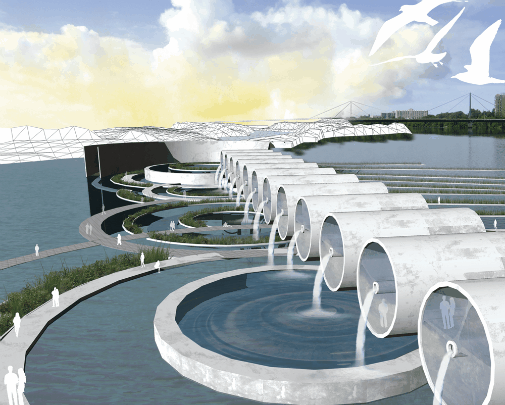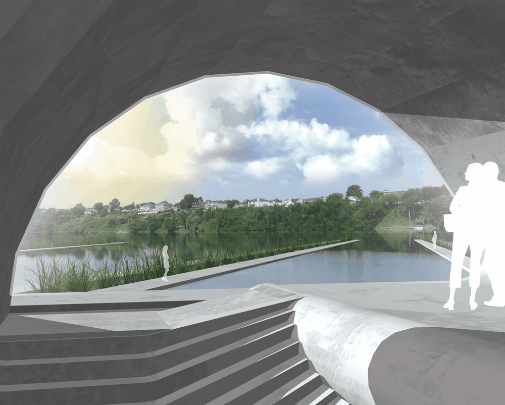 [Hydro park adds a public park, animal habitats and water treatment to an existing dam ]Infranet Lab pointed us to a recent thesis project at McGill University by Tania Delage who takes Lebbeus Woods’ idea of the borderline and the ecological phenomena of the ecotone as an opportunity to cross-breed infrastructure, ecology and public amenities.
[Hydro park adds a public park, animal habitats and water treatment to an existing dam ]Infranet Lab pointed us to a recent thesis project at McGill University by Tania Delage who takes Lebbeus Woods’ idea of the borderline and the ecological phenomena of the ecotone as an opportunity to cross-breed infrastructure, ecology and public amenities.
The borderline is the site where various systems collide, superimpose, or react to create a new condition. (Woods) These systems can vary greatly in scope; from social conditions to ecological and biological conditions. They may be tied to shifts in economic activity, technological advancements, obsolete or growing infrastructure, and environmental phenomena. Ecotones are the natural spaces where transformation and growth occur, typically at borderline site conditions. It is these sites of superimposed systems that provide the grounds for a new ‘mode of culture.’
At an ecological scale, the site is the Great Lakes basin and Saint-Lawrence River, the largest freshwater system of the world. The watershed is home to many ecological systems and provides important migratory routes for fish that spawn in fresh water only to return to their salt water habitat. Ringed by areas of intense urbanization, the watershed represents a major transportation artery for commercial navigation and provides a source of hydro electric power to the surrounding areas. The waterway also serves as an open sewer to cities along its shore, as it simultaneously supplies their drinking water.
 [1 Aerobic filtration gardens, 2 Sedimentation gardens, 3 Fish ladders, 4 Visitor pathways]
[1 Aerobic filtration gardens, 2 Sedimentation gardens, 3 Fish ladders, 4 Visitor pathways]
The area of the project's focus is this mashing of man-made infrastructure and ecologies. The summary of the project which you can read in full here, aims to reconfigure uses seen only as utilitarian and humanize them, creating multiple functions serving both man and nature.
 [Visitors walk on pathways, alongside fish ladders which help reestablish migratory routes displaced during the original construction of the dam]
[Visitors walk on pathways, alongside fish ladders which help reestablish migratory routes displaced during the original construction of the dam]
The current hydro-electric damn becomes a shared ecology, withdrawing the focus of one element to one system but a holistic design approach to handling severely complicated infrastructural and ecological systems. "Elements of the landscape become submerged, no longer suitable for human inhabitation but become appropriate for different types of wildlife. Part infrastructure, part landscape, the park becomes a shifting exchange point between water systems, energy resources, human users and animal habitats."
Despite some negative feedback I've read on other blogs showcasing student work, I believe academics and student work to hold a strong importance in the Landscape Architecture world. It's many of these ideas, while possibly not currently actionable, that lead others to the actual fruition and engineering of the concepts.
 [View of finger-like aerobic filtration gardens, and ringed sedimentaion gardens, which together form natural filtration system for the river water]
[View of finger-like aerobic filtration gardens, and ringed sedimentaion gardens, which together form natural filtration system for the river water]
Blending infrastructures and ecologies at fringe environments certainly seems a necessary future for further growth development. Naturally we have heaps hurdles. We'll undoubtedly incur sanitation issues combining transitions of natural wet to dry, fish/fowl to human. And we'll need creative safety and noise reduction solutions to ever consider this park a place for people. But we're not necessarily keen on current practicality here at D.U.S. Landscape Architecture needs progressives and forward thinkers. We need at least sometimes to think about the "what ifs?" rather then simply "we don't know how?"
 [Inhabiting the Ecotone Hydro park]
[Inhabiting the Ecotone Hydro park]
